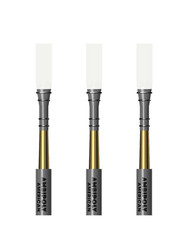Ambipoly 2nd Generation Synthetic American Oboe Reed Review
Posted by Ann Hodge on Apr 6th 2024
For years, if American oboists wanted the consistency, longevity, and stability that quality synthetic oboe reeds offer, they have been forced to struggle with European-style reeds completely different from what they were used to. That struggle is over!
Silverstein has now come out with what they are calling the Ambipoly 2nd Generation American-style synthetic oboe reed!
There are numerous improvements with this reed. The first is that it is on a Chiarugi 2 staple which is much more standard in America. The sound quality has also improved, producing a relatively dark sound with more overtones and warmth to the sound than their first attempt. Additionally, the intonation of the scale is vastly improved. Unfortunately, on my oboe, all the reeds were flat.
Crow
The crow is right on C6, albeit in the middle of the reed and only while blowing softly. When you go down to where you would normally get a crow by the thread, it squeaks.
Playing
I’m very excited about the possibilities in this reed. It was very responsive with a dark, round tone, just as they advertise on their website. It was easy to articulate and play on like a decent cane reed. Some reeds had a bigger opening than others but all were usable; you don’t want to bite and you don’t need a tough embouchure. With an open embouchure, the reed is very responsive to changes in dynamics and articulation, tone color and range.
Intonation
The overall intonation of the reed was very flat to start with. Individual notes were not 100% in tune with each other but they were a lot closer than the 1st Generation reeds. I was able to bring the pitch up by clipping the reed.
Scrape
It’s responsive with a clearly felt heart, back, and spine. (It is difficult to see it though because the polymer is so clear.) The tip is fairly long and clearly defined at the sides but flows smoothly from the heart to the tip. A second level of thinness is achieved near the end of the tip, making the reed very responsive. The manufacturer leaves the very end of the reed slightly thicker, though, so the player can customize the resistance of the reed. I scraped off this thickness for a smooth scrape to the finish. This freed up the reed to vibrate without what I felt was unwanted resistance. There is a European-style moon shape where the back goes into the heart. I'm not sure why they did this but it felt like the back was too stiff and was affecting the warmth of the sound negatively. I scraped the back like I would an American reed so that it was less stiff and it did add some warmth to the sound.
Shape
The shape is Ambipoly’s proprietary shape that was chosen because it worked the best with the material. A bit wide for an American reed, it makes up for it in the straight sides that only narrow near the bottom.
Staple
The Ambipoly 2nd Generation American Reed comes on a #2 Chiarugi cork staple. This is a very standard staple size for Americans and works pretty well with this reed, although in my instrument, all the reeds were flat to start with. These new generation reeds are not able to be taken off the staple.
Adjusting the Reed
Yes! You can scrape on this with a regular reed knife. It felt harder than cane. I needed to put more pressure behind the blade and not as much came off, but you can definitely scrape this like cane. I felt like it dulled my knife very quickly so I would suggest using the ReedGeek instead.
Ambipoly reeds are designed to be playable out of the box, but do have enough material left to make any adjustments you want. I felt like this reed plays like a medium and could have had more material taken out in the back.
The reed comes with a slightly thicker tip to allow for adjusting. I felt the need to take a little off on the corners mostly.
Final Verdict
These are a significant improvement to the 1st Generation reeds. While I ended up liking my 1st Generation reed for practicing, after changing the staple, I felt that these reeds have more consistency and potential for being a good reed right out of the box. Unfortunately, as I experimented with scraping on one reed, I clipped more off than I should have and felt like I lost the warmer tone quality. Overall, these 2nd generation Ambipoly American reeds are pretty good and I recommend trying one.

